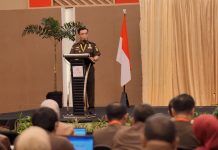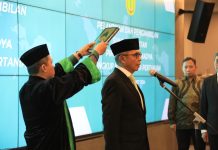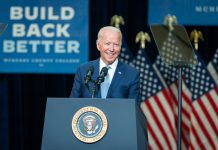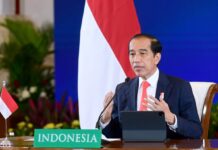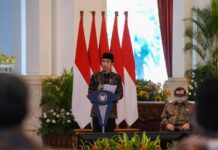WASHINGTON, Legion News — In the past week, President Donald Trump hosted an indoor campaign rally for thousands of cheering, unmasked supporters even as a deadly virus spread throughout the country. He began easing up on restrictions that had been in place at the White House since Washington instituted a stay-at-home order in response to the coronavirus in March, and he invited the president of Poland to a day of meetings. Then, Thursday, he flew to Wisconsin to brag about an economic recovery that he said was just around the corner.

But by Friday, it was impossible to fully ignore the fact that the pandemic the White House has for weeks insisted was winding down has done just the opposite.
The rising numbers in Texas, Florida and Arizona made that clear, as well as the reality that those are all states where the president and his Republican allies had urged people to return to normal.
In a reflection of a growing sense of anxiety over the new numbers, Vice President Mike Pence and members of the coronavirus task force held a public briefing for the first time in two months. But ever loyal to Trump’s desire for good news, Pence tried to tiptoe around the statistics that Dr. Deborah L. Birx, the task force coordinator, pointed to, showing surging cases and hospitalizations in Florida, Texas, Arizona and other states.
“We have made a truly remarkable progress in moving our nation forward,” the vice president said. “We’ve all seen the encouraging news as we open up,” he added, dismissing any suggestion that the outbreaks across the South should prompt a return to the shutdowns that Trump so badly wants to be over. “The reality is we’re in a much better place.”

Refusing to wear a mask even as the health officials next to him did, Pence described the recent outbreaks across the country as little more than the product of increased testing among younger, more healthy Americans who should be less likely to get seriously ill from the coronavirus even as they spread it to others.
“Very encouraging news,” he said.
But Pence’s comments came against the backdrop of a very different message from Birx and Dr. Anthony S. Fauci, the nation’s top infectious disease expert, who warned of a broken testing system and said the outbreaks could engulf the country.
“If we don’t extinguish the outbreak, sooner or later, even ones that are doing well are going to be vulnerable to the spread,” he warned. “So we need to take that into account because we are all in it together. And the only way we’re going to end it is by ending it together.”
The return of the televised task force news conference — at which reporters were limited to only a handful of questions — revived the deep disconnect between Washington and the states where local officials spent Friday sounding the alarm and, in some cases, halting the reopening that Trump has so often encouraged.

In Florida, Gov. Ron DeSantis, a Republican who has resisted rolling back the economic reopening, banned drinking in bars after saying that patrons were not abiding by social distancing rules. In Texas, Gov. Greg Abbott, also a Republican, went further, ordering all bars closed in the state. And Judge Lina Hidalgo of Harris County, the largest county in Texas, reimposed stay-at-home orders Friday, calling the rise in cases there “a catastrophic and unsustainable situation.”
Taken together, it was grim news about a pandemic that is still a threat to the public’s health, the nation’s economy and the president’s political future.
At a time when his poll numbers now call into question whether he can win a second term in November, Trump faces the prospect that his efforts to boost the economy by shrugging off the virus have backfired. Rather than head into the summer with a country on the mend, the president will be forced to explain how his response to the coronavirus contributed to a resurgence of it that may force some Americans back into a painful shutdown.
And yet Trump made no appearance at the task force briefing to demonstrate concern. Instead, an hour after it was over, the president addressed a panel of industry officials, political allies and White House economic advisers for a self-congratulatory session about how successful the economic recovery has been.

In taking his victory lap, Trump made no mention of the increase in cases around the country, underscoring a message that he posted on Twitter late Thursday night: “Our Economy is roaring back and will NOT be shut down. ‘Embers’ or flare ups will be put out, as necessary!”
All spring, Trump expressed his impatience and annoyance with the social distancing measures that various states, and his own aides, were taking.
He showed some concern when his personal valet, who serves his food, was diagnosed with the coronavirus and Pence’s press secretary tested positive. But since then, Trump has maintained a posture of denial and dismissiveness.
He has been enabled by a handful of advisers, some of whom share his desire to focus on the economy and some of whom are afraid of the president’s reaction if they press him too hard about the public health crisis unfolding once again in large chunks of the country.

“If we don’t extinguish the outbreak, sooner or later, even ones that are doing well are going to be vulnerable to the spread,” he warned. “So we need to take that into account because we are all in it together. And the only way we’re going to end it is by ending it together.”
The return of the televised task force news conference — at which reporters were limited to only a handful of questions — revived the deep disconnect between Washington and the states where local officials spent Friday sounding the alarm and, in some cases, halting the reopening that Trump has so often encouraged.
The return of the televised task force news conference — at which reporters were limited to only a handful of questions — revived the deep disconnect between Washington and the states where local officials spent Friday sounding the alarm and, in some cases, halting the reopening that Trump has so often encouraged.
In Florida, Gov. Ron DeSantis, a Republican who has resisted rolling back the economic reopening, banned drinking in bars after saying that patrons were not abiding by social distancing rules. In Texas, Gov. Greg Abbott, also a Republican, went further, ordering all bars closed in the state. And Judge Lina Hidalgo of Harris County, the largest county in Texas, reimposed stay-at-home orders Friday, calling the rise in cases there “a catastrophic and unsustainable situation.”
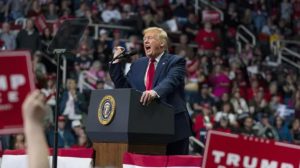
Taken together, it was grim news about a pandemic that is still a threat to the public’s health, the nation’s economy and the president’s political future.
At a time when his poll numbers now call into question whether he can win a second term in November, Trump faces the prospect that his efforts to boost the economy by shrugging off the virus have backfired. Rather than head into the summer with a country on the mend, the president will be forced to explain how his response to the coronavirus contributed to a resurgence of it that may force some Americans back into a painful shutdown.
And yet Trump made no appearance at the task force briefing to demonstrate concern. Instead, an hour after it was over, the president addressed a panel of industry officials, political allies and White House economic advisers for a self-congratulatory session about how successful the economic recovery has been.
In taking his victory lap, Trump made no mention of the increase in cases around the country, underscoring a message that he posted on Twitter late Thursday night: “Our Economy is roaring back and will NOT be shut down. ‘Embers’ or flare ups will be put out, as necessary!”
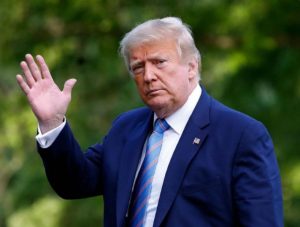
All spring, Trump expressed his impatience and annoyance with the social distancing measures that various states, and his own aides, were taking.
He showed some concern when his personal valet, who serves his food, was diagnosed with the coronavirus and Pence’s press secretary tested positive. But since then, Trump has maintained a posture of denial and dismissiveness.
He has been enabled by a handful of advisers, some of whom share his desire to focus on the economy and some of whom are afraid of the president’s reaction if they press him too hard about the public health crisis unfolding once again in large chunks of the country.
The White House chief of staff, Mark Meadows, has been among the chief proponents of keeping the administration’s public health experts largely out of sight, according to several senior administration officials.
But he is not alone. Even though they are aware that Trump’s mishandling of the virus presents a threat to his reelection, his campaign advisers agreed to his demand for the rally last Saturday at an arena in Tulsa, Oklahoma, hoping the adulation he would receive there would snap the president out of a funk he has been in for months.
But at least eight staff members — including two Secret Service agents — tested positive for the virus before the rally, which was lightly attended and attracted none of the overflow crowd that Trump’s advisers had promised. Since then, dozens of campaign aides who were in Oklahoma for the event have been told to quarantine.
His advisers are now trying to figure out how to give Trump the traveling road show he wants while acknowledging the widespread fears about the coronavirus and allowing for proper health measures. At the same time, the White House has stopped employing the health checks it had been using for several weeks, like temperature checks for people entering the complex.
One of the states where the cases are rising drastically is Florida, where Trump insisted the Republican National Convention at the end of August be relocated to meet his desire for a large-scale event free of social distancing measures. As of now, Republicans hope to put on a show celebrating Trump, the first lady and Pence with three nights of crowds as large as 12,000 people in Jacksonville.
Some of the president’s political allies have signaled in recent days that they intend to take the threat of the virus more seriously.
Speaking to a group of health care workers in Morehead, Kentucky, Sen. Mitch McConnell, R-Ky., the majority leader, held up a simple face mask.
“Until we find a vaccine, these are really important,” the senator said. “This is not as complicated as a ventilator. This is a way to indicate that you want to protect others. We all need during this period until we find a vaccine to think of us as protecting not only ourselves but others.”
And Rep. Liz Cheney, R-Wyo., had a not-so-subtle message for Pence in a tweet she posted not long after the vice president refused to wear a mask during the task force briefing Friday. Her tweet included a picture of her father, former Vice President Dick Cheney.
“Dick Cheney says WEAR A MASK,” she wrote, adding the hashtag: #realmenwearmasks.
But if anything, Trump, Pence and the rest of the senior members of the administration have seemed determined in the past 24 hours to embrace a previrus political reality — even if the medical facts contradict it.
On Thursday night, the Trump administration asked the Supreme Court to overturn the Affordable Care Act, a move that, if successful, would bring a permanent end to the health insurance program popularly known as Obamacare and wipe out coverage for as many as 23 million Americans.
In an 82-page brief, the administration joined Republican officials in Texas and 17 other states in arguing that in 2017, Congress, then controlled by Republicans, had rendered the law unconstitutional when it zeroed out the tax penalty for not buying insurance — the so-called individual mandate.
The president’s argument is sure to reignite Washington’s bitter political debate over access to affordable health care even as the accelerating pandemic has left millions of unemployed Americans without employer-provided health coverage.
This article originally appeared in The New York Times.


